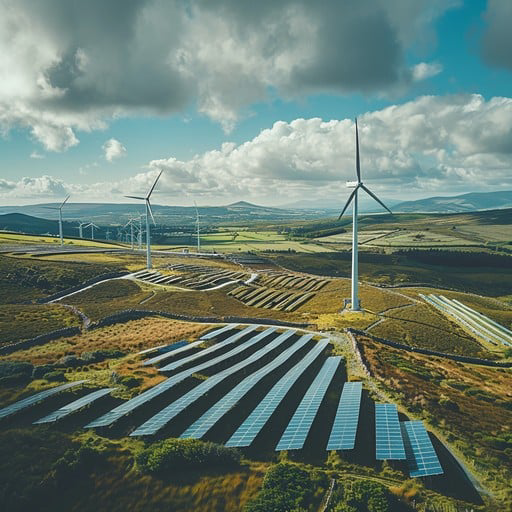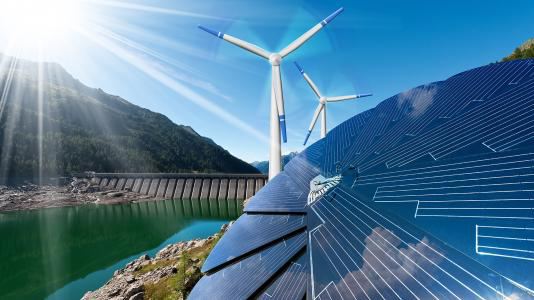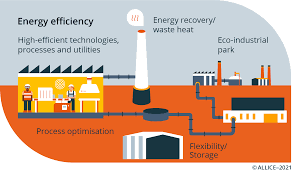In a world where the demand for energy is skyrocketing and the environmental toll of traditional energy sources is becoming impossible to ignore, the need for innovative energy management has never been more urgent. Fossil fuels, while once the backbone of global energy systems, are now seen as a relic of the past finite, polluting, and unsustainable. Step into the era of green energy, the foundation of a cleaner and greener world. At the forefront of this transformation is the Ambani Group, a global leader in sustainable energy solutions that is redefining how energy is produced, distributed, and consumed.
Through cutting-edge technologies and an unwavering commitment to sustainable energy practices, the Ambani Group is pioneering a future where energy is not only abundant but also eco-friendly. From harnessing the power of the sun and wind to optimizing resources with intelligent systems, the group is setting new benchmarks for the energy sector. This article delves into the Ambani Group’s groundbreaking strategies, exploring how their innovative energy methods are driving the global transition to green energy. Whether you’re an industry professional or simply curious about the future of energy, this guide offers valuable insights into the transformative power of sustainable solutions.

The Importance of Energy Resource Management
Our planet is under immense pressure. The demand for energy is growing exponentially, and traditional energy sources like coal and oil are not only finite but also detrimental to the environment. This is where energy management comes into play. It’s about using energy wisely such as reducing waste, optimizing consumption, and embracing cleaner alternatives.
The Ambani Group has taken this challenge head-on. By leveraging cutting-edge technologies and sustainable energy practices, they’re setting new standards for the industry. Their approach is not just about meeting energy demands but doing so in a way that is efficient, sustainable, and future-ready. (International Energy Agency (IEA). (2021). Global Energy Review: The Transition to Clean Energy.)
Ambani Group’s Vision for Sustainable Energy
The Ambani Group has long been synonymous with innovation and excellence. Their commitment to sustainable energy practices is evident in their strategic initiatives, which focus on three core pillars:
- Renewable Energy Integration: Transitioning from fossil fuels to renewable energy sources like solar, wind, and hydrogen. (International Renewable Energy Agency (IRENA). (2021). Renewables in the Energy Transition.)
- Energy Efficiency: Implementing advanced technologies to reduce energy consumption and waste. (United Nations Framework Convention on Climate Change (UNFCCC). (2020). Energy Transition for a Sustainable Future.)
- Resource Optimization: Maximizing the use of available resources through intelligent systems and data-driven decision-making.
These efforts not only align with global sustainability goals but also position the Ambani Group as a leader in the energy sector.

Green Energy: The Heart of Ambani Group’s Strategy
At the core of the Ambani Group’s mission is its dedication to green energya commitment to harnessing natural resources in an environmentally friendly manner. The group’s energy resources are tailored to the natural conditions and circumstances of each region, ensuring optimal energy generation with minimal ecological impact.
What is Green Energy?
Green energy refers to energy produced from natural, renewable sources that have a minimal environmental footprint. Unlike traditional energy sources like coal, oil, and gas, green energy is derived from resources such as sunlight, wind, and water, which are inexhaustible and eco-friendly. By integrating these green energy sources, the Ambani Group is not only reducing its carbon footprint but also paving the way for a sustainable energy future. (International Renewable Energy Agency (IRENA). (2021). Renewable Energy Benefits: Measuring the Economics.)

Energy Efficiency
Energy efficiency is another cornerstone of the Ambani Group’s strategy. The group has implemented cutting-edge technologies and processes to minimize energy waste and optimize consumption.
- Smart Grids: The deployment of smart grids allows for real-time monitoring and control of energy distribution. These grids use sensors, IoT devices, and advanced analytics to detect inefficiencies, reduce energy losses, and ensure a stable supply. (International Energy Agency (IEA). (2020). Smart Grids for a Sustainable Energy Future.)
- Energy-Efficient Infrastructure: From energy-efficient buildings to optimized industrial processes, the Ambani Group is redefining how energy is used across its operations. For example, their facilities incorporate LED lighting, energy-efficient HVAC systems, and automated energy management systems. (U.S. Department of Energy (DOE). (2019). Energy Efficiency and Smart Infrastructure Report.)
- Demand-Side Management: By encouraging consumers to shift their energy usage to off-peak hours, the group reduces strain on the grid and lowers overall energy costs.
These initiatives demonstrate the Ambani Group’s commitment to doing more with less, ensuring that every unit of energy is used effectively.
Resource Optimization
Resource optimization is about maximizing the value derived from available resources while minimizing waste. The Ambani Group leverages advanced technologies and data-driven approaches to achieve this goal.
- Intelligent Systems: The group uses AI and machine learning to analyze energy consumption patterns, predict demand, and optimize resource allocation. This ensures that energy is distributed where it’s needed most, reducing inefficiencies. (International Energy Agency (IEA). (2021). Resource Optimization Through AI and IoT Technologies.)
- Circular Economy Practices: The Ambani Group promotes a circular economy by recycling and reusing materials wherever possible. For instance, waste heat from industrial processes is captured and repurposed for other applications, reducing overall energy consumption. (Ellen MacArthur Foundation. (2019). Circular Economy in Energy Management.)
- Water and Waste Management: Beyond energy, the group focuses on optimizing water usage and minimizing waste. Advanced water treatment plants and zero-waste policies ensure that resources are used responsibly and sustainably.
Through these efforts, the Ambani Group is setting a new standard for resource optimization in the energy sector.
Benefits of Green Technology: A Deep Dive
Green technology, also known as clean technology, is revolutionizing the way we produce and consume energy. By focusing on renewable resources and sustainable practices, green technology offers a wide range of benefits that extend beyond environmental protection. Below, we explore the key benefits of green technology in detail, supported by references and data.

1. Environmental Sustainability
Environmental sustainability is at the heart of green technology. By reducing reliance on fossil fuels and minimizing environmental degradation, green technology helps preserve the planet for future generations.
Key Contributions to Environmental Sustainability
- Reduction in Greenhouse Gas Emissions Green technologies like solar, wind, and hydropower produce little to no greenhouse gas emissions during operation. According to the International Renewable Energy Agency (IRENA), renewable energy could reduce global carbon dioxide emissions by 70% by 2050, significantly mitigating climate change. (International Renewable Energy Agency (IRENA). (2021). Renewable Energy and Climate Change.)
- Minimized Air and Water Pollution Unlike fossil fuels, green energy sources do not release harmful pollutants like sulfur dioxide, nitrogen oxides, or particulate matter. A study by the National Renewable Energy Laboratory (NREL) found that widespread adoption of renewable energy could prevent 4.2 million premature deaths annually by reducing air pollution. (National Renewable Energy Laboratory (NREL). (2020). Health Benefits of Renewable Energy.)
- Preservation of Natural Ecosystems Green technologies like small-scale hydropower and solar farms have a minimal ecological footprint compared to traditional energy sources, helping to protect biodiversity and natural habitats.

2. Cost Savings
While the initial investment in green technology can be high, the long-term cost savings are substantial. Green technologies reduce operational costs, lower energy bills, and provide economic benefits to both businesses and consumers.
Key Areas of Cost Savings
- Lower Energy Costs Renewable energy sources like solar and wind have become increasingly affordable. According to the International Renewable Energy Agency (IRENA), the cost of solar power has dropped by 89% since 2010, making it one of the most cost-effective energy sources today. (International Renewable Energy Agency (IRENA). (2021). The Cost Reduction Trends in Renewable Energy.)
- Reduced Dependency on Fossil Fuels By generating energy locally, green technologies reduce the need for imported fossil fuels, which are subject to price volatility. This ensures stable and predictable energy costs.
- Operational Efficiency Green technologies like smart grids and energy-efficient infrastructure optimize energy use, reducing waste and lowering operational costs.
3. Long-Term Sustainability
Green technology is not just a short-term solution but a long-term strategy for sustainable development. By investing in renewable energy and sustainable practices, we can ensure a stable and resilient energy future.
Key Contributions to Long-Term Sustainability
- Energy Security Renewable energy sources like solar, wind, and hydropower are locally available and abundant, reducing vulnerability to geopolitical tensions and supply chain disruptions. According to the U.S. Energy Information Administration (EIA), renewable energy is expected to account for 42% of global electricity generation by 2050, ensuring a more secure energy future. (U.S. Energy Information Administration (EIA). (2023). International Energy Outlook.)
- Job Creation and Economic Growth The renewable energy sector is a major driver of job creation, employing over 12 million people globally in 2022, according to the International Labour Organization (ILO). Green technologies also stimulate economic growth by attracting investments and fostering innovation. (International Labour Organization (ILO). (2022). Renewable Energy and Jobs: Annual Review.)
- Scalability and Adaptability Green technologies are highly scalable and can be adapted to meet the energy needs of diverse settings, from urban centers to remote rural areas.

Conclusion
The Ambani Group’s innovative approaches to energy resource management are more than just a response to global energy challenges as they are a blueprint for a sustainable future. By embracing renewable energy, optimizing resource use, and leveraging cutting-edge technologies, the group is setting new standards for the energy sector. Their commitment to green energy and sustainable practices is not only reducing carbon emissions but also driving economic growth and creating jobs.
As we look to the future, the Ambani Group’s strategies offer a clear roadmap for success. Their work demonstrates that sustainability and innovation can go hand in hand, proving that a cleaner, greener world is within reach. The question now is not whether we can achieve this future, but how quickly we can get there.
Join the Ambani Group in their mission to revolutionize energy management. Whether it’s adopting energy-efficient practices, supporting renewable energy initiatives, or simply spreading awareness, every action counts. Together, we can build a future powered by clean, sustainable energy as one that benefits both people and the planet.

References
- International Renewable Energy Agency (IRENA). (2021). Renewable Energy and Climate Change.
https://www.irena.org/publications/2021/Jun/Renewable-Energy-and-Climate-Change - National Renewable Energy Laboratory (NREL). (2020). Health Benefits of Renewable Energy.
https://www.nrel.gov/docs/fy20osti/76611.pdf - U.S. Energy Information Administration (EIA). (2023). International Energy Outlook.
https://www.eia.gov/outlooks/ieo/ - International Labour Organization (ILO). (2022). Renewable Energy and Jobs: Annual Review.
https://www.ilo.org/global/topics/green-jobs/publications/annual-review/2022/lang–en/index.htm